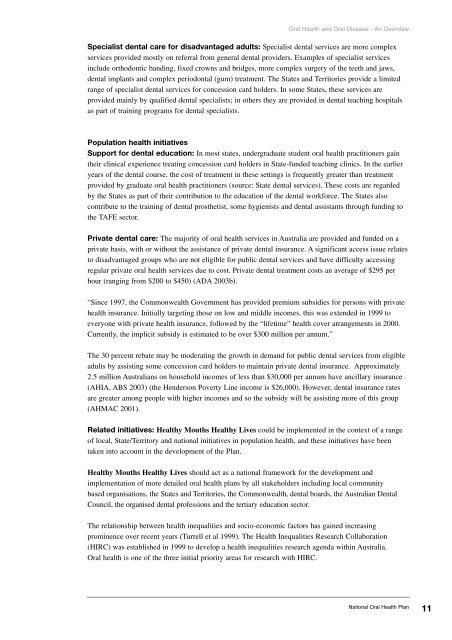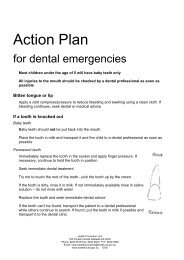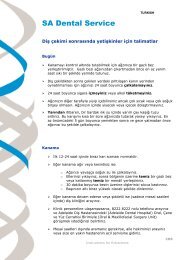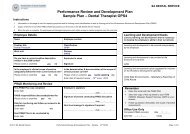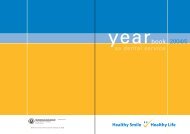National Oral Health Plan - Australian Dental Association
National Oral Health Plan - Australian Dental Association
National Oral Health Plan - Australian Dental Association
You also want an ePaper? Increase the reach of your titles
YUMPU automatically turns print PDFs into web optimized ePapers that Google loves.
<strong>Oral</strong> <strong>Health</strong> and <strong>Oral</strong> Disease - An Overview<br />
Specialist dental care for disadvantaged adults: Specialist dental services are more complex<br />
services provided mostly on referral from general dental providers. Examples of specialist services<br />
include orthodontic banding, fixed crowns and bridges, more complex surgery of the teeth and jaws,<br />
dental implants and complex periodontal (gum) treatment. The States and Territories provide a limited<br />
range of specialist dental services for concession card holders. In some States, these services are<br />
provided mainly by qualified dental specialists; in others they are provided in dental teaching hospitals<br />
as part of training programs for dental specialists.<br />
Population health initiatives<br />
Support for dental education: In most states, undergraduate student oral health practitioners gain<br />
their clinical experience treating concession card holders in State-funded teaching clinics. In the earlier<br />
years of the dental course, the cost of treatment in these settings is frequently greater than treatment<br />
provided by graduate oral health practitioners (source: State dental services). These costs are regarded<br />
by the States as part of their contribution to the education of the dental workforce. The States also<br />
contribute to the training of dental prosthetist, some hygienists and dental assistants through funding to<br />
the TAFE sector.<br />
Private dental care: The majority of oral health services in Australia are provided and funded on a<br />
private basis, with or without the assistance of private dental insurance. A significant access issue relates<br />
to disadvantaged groups who are not eligible for public dental services and have difficulty accessing<br />
regular private oral health services due to cost. Private dental treatment costs an average of $295 per<br />
hour (ranging from $200 to $450) (ADA 2003b).<br />
“Since 1997, the Commonwealth Government has provided premium subsidies for persons with private<br />
health insurance. Initially targeting those on low and middle incomes, this was extended in 1999 to<br />
everyone with private health insurance, followed by the “lifetime” health cover arrangements in 2000.<br />
Currently, the implicit subsidy is estimated to be over $300 million per annum.”<br />
The 30 percent rebate may be moderating the growth in demand for public dental services from eligible<br />
adults by assisting some concession card holders to maintain private dental insurance. Approximately<br />
2.5 million <strong>Australian</strong>s on household incomes of less than $30,000 per annum have ancillary insurance<br />
(AHIA, ABS 2003) (the Henderson Poverty Line income is $26,000). However, dental insurance rates<br />
are greater among people with higher incomes and so the subsidy will be assisting more of this group<br />
(AHMAC 2001).<br />
Related initiatives: <strong>Health</strong>y Mouths <strong>Health</strong>y Lives could be implemented in the context of a range<br />
of local, State/Territory and national initiatives in population health, and these initiatives have been<br />
taken into account in the development of the <strong>Plan</strong>.<br />
<strong>Health</strong>y Mouths <strong>Health</strong>y Lives should act as a national framework for the development and<br />
implementation of more detailed oral health plans by all stakeholders including local community<br />
based organisations, the States and Territories, the Commonwealth, dental boards, the <strong>Australian</strong> <strong>Dental</strong><br />
Council, the organised dental professions and the tertiary education sector.<br />
The relationship between health inequalities and socio-economic factors has gained increasing<br />
prominence over recent years (Turrell et al 1999). The <strong>Health</strong> Inequalities Research Collaboration<br />
(HIRC) was established in 1999 to develop a health inequalities research agenda within Australia.<br />
<strong>Oral</strong> health is one of the three initial priority areas for research with HIRC.<br />
<strong>National</strong> <strong>Oral</strong> <strong>Health</strong> <strong>Plan</strong><br />
11


